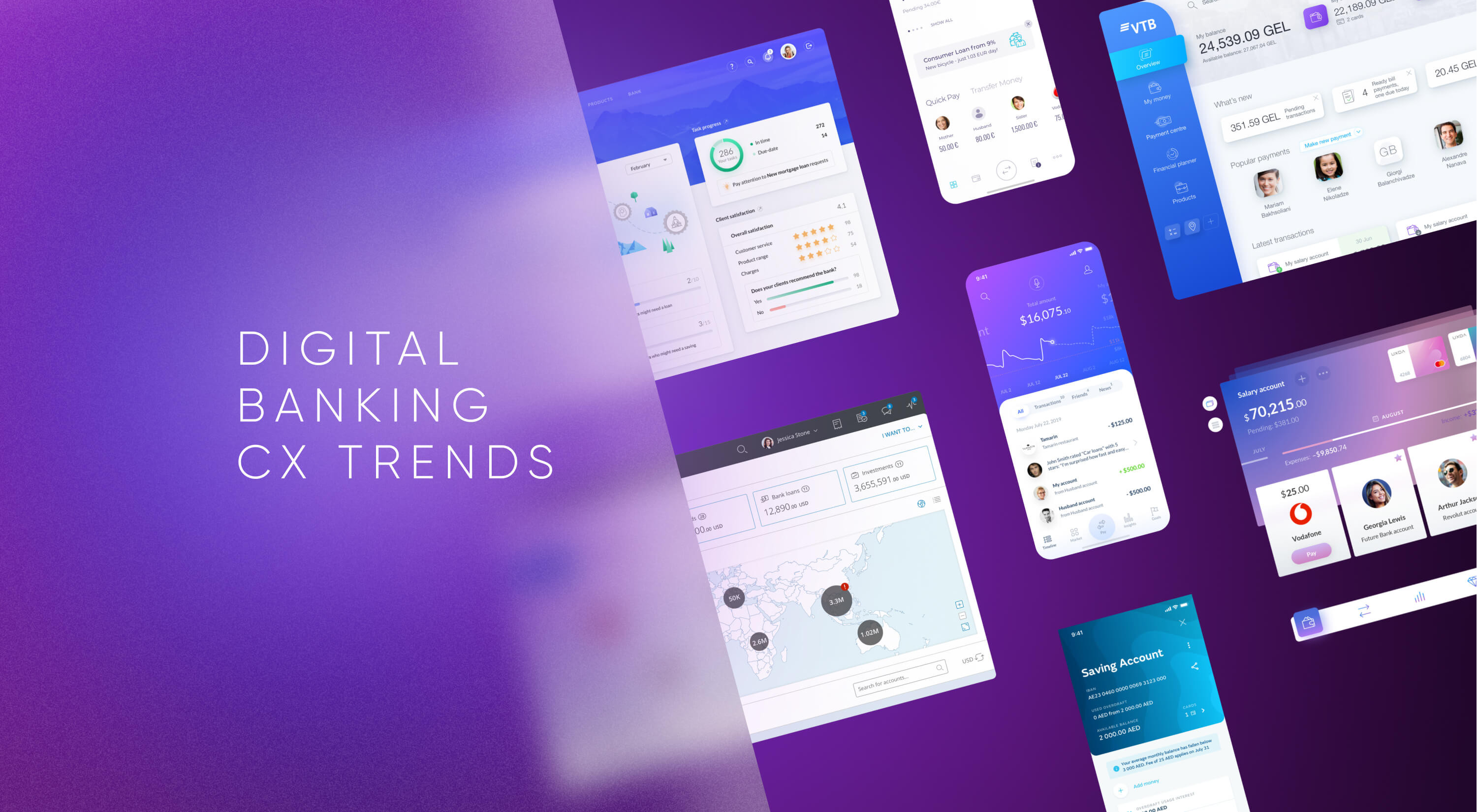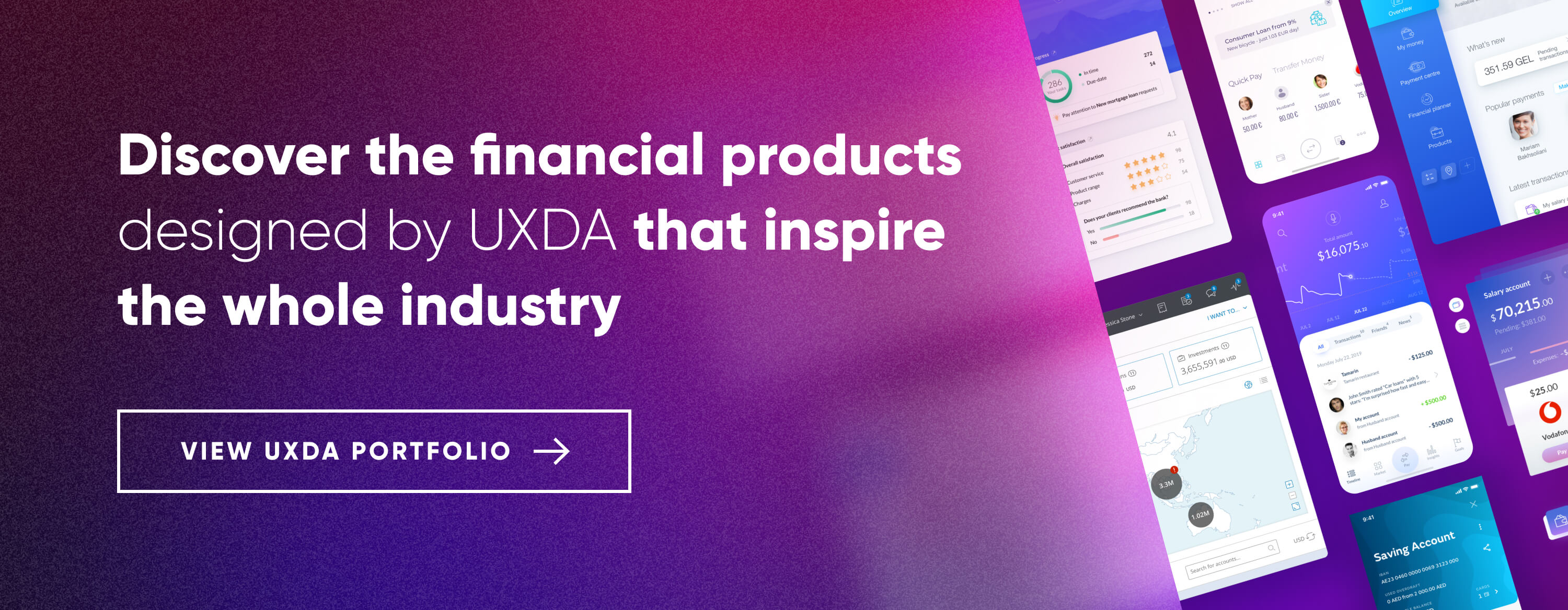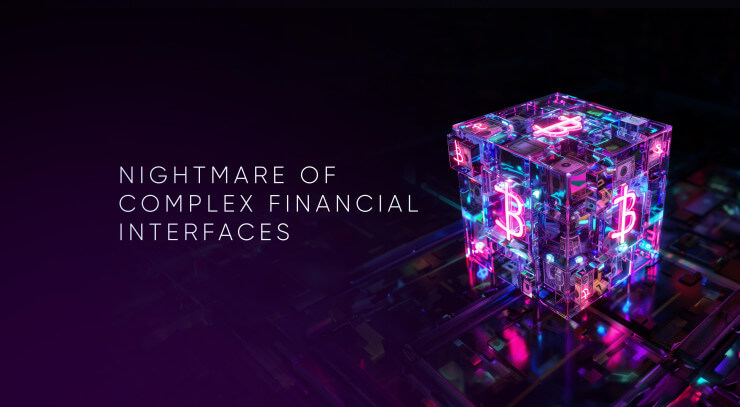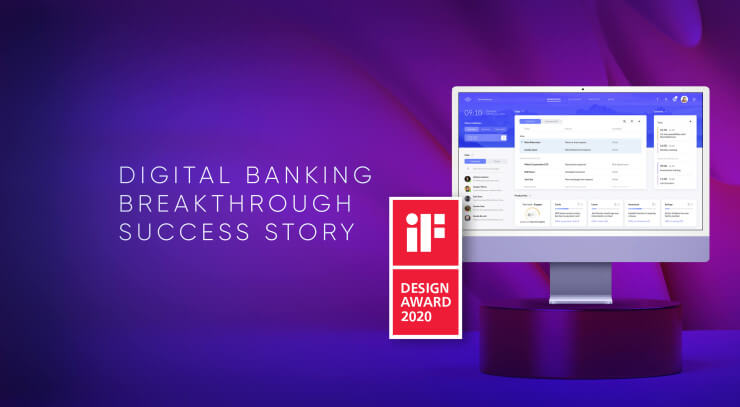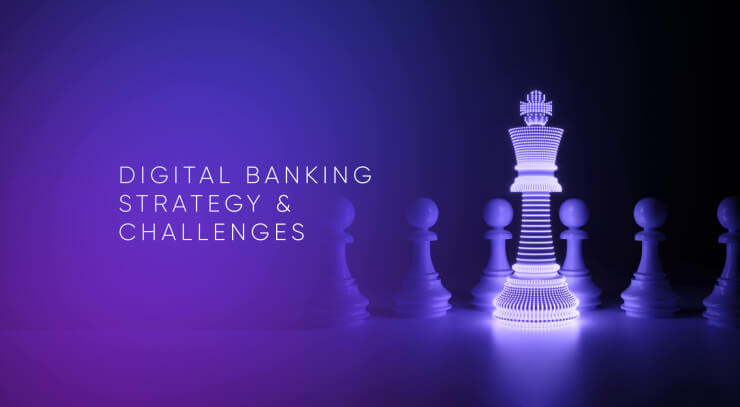The post-pandemic created a monumental shift from physical to digital by accelerating the natural progress of digital banking customer experience many times over. People have adopted new behaviors that will become habit-forming. Just being digitally developed is not enough to ensure the existence of any financial company. Extreme customer-centricity is becoming a MUST to adapt to the post-pandemic world. 10 digital banking customer experience trends will help you to define the right strategy for the post-pandemic.
You've got to start with the customer experience and work back toward the technology - not the other way around.
Steve Jobs, May 1997, World Wide Developers Conference
If it wasn't for the pandemic, this article might have covered a slightly different selection of digital banking customer experience trends. The unique situation of the last few years has definitely left its mark and accelerated the importance of digitalization and user-centricity more than ever. It has completely shifted the customer behaviors and expectations toward the financial brands, forcing FIs to re-think obsolete ways of operating and doing that expeditiously.
Listen to this article in audio format:
As Microsoft CEO Satya Nadella put it, “We’ve seen two years’ worth of digital transformation in two months.” No doubt this was a hard hit for many businesses, but especially for the finance industry as it clearly wasn't even partially digitized up to the point when it all happened.
TOP 10 Digital Banking Customer Experience Trends
Amid the pandemic, 88% of customers expected companies to accelerate their digital initiatives, while 68% stated that COVID-19 elevated their expectations of brands’ digital capabilities, according to Salesforce.
All that's been happening around the globe intensified the significance of every digital banking trend. The bar is set very high in terms of digital banking customer experience and digital transformation efforts as a brand new generation of post-COVID customers is emerging. Seventy-five percent of customers have tried different brands since the pandemic started, while 60% of those consumers expect to adopt new brands and stores into their post-pandemic lives and routines, according to McKinsey research.
Loyalty, empathy and emotional connection are cornerstones to bond the financial brands with their customers. Seventy-one percent of customers state that now is the time for businesses to update and upgrade how they operate, engage and contribute to society across a variety of fronts, according to Salesforce.
So, let's explore how a digital strategy empowered by banking customer experience design can help financial brands transform and adapt to the emergence of the new post-COVID paradigm.
1. Expanding the Digital Perspective
The global transition to digital technologies has opened up brand new possibilities, especially in a lockdown situation. Still, these new opportunities are yet to be discovered and utilized to the fullest, especially when it comes to the banking and finance industry.
Almost 70% of customers expect companies to create new ways to get existing products and services, e.g., digital versions of traditionally in-person experiences in response to the pandemic, while 54% want expanded engagement methods and also modern types of products and services, according to Salesforce.
Despite the obvious need for well-developed digital channels and top-notch banking customer experiences, the pandemic has highlighted the fact that the financial industry is woefully unprepared to embrace the digital age. In a situation in which digital means everything, it seems absurd that there are still cases in which people are expected to risk their health just to visit a banking branch.
What makes this situation even more unfortunate is that all the necessary technologies to avoid such situations are already available to the banks, but, for some reason, they are not utilized effectively enough to guarantee a completely remote service.
In such uncertain times, when the importance of digitalization is stressed, it's critical to carefully evaluate the proper way to create and integrate a digital strategy. Otherwise, there's a big possibility of reliving the unfortunate situation in the recent past when financial institutions were the last ones to develop mobile channels while almost the whole world was already relying on them.
“The number one bank in the world will be a technology company,” as Brett King, Fintech influencer, author and futurist, predicted. It's true. The banks of the future need to become digital and create their digital strategies accordingly. It's unimaginable that a digital company would be slow in adapting to technological advancements.
Successful digital businesses are always two steps ahead, constantly monitoring the changing customer behavior and innovating new ways to adapt their products and create new ones according to the rising expectations.
The same kind of thinking applies to FIs that aim to succeed. Financial brands that want to become the leaders of the future have already started to develop their digital competencies to instantly adapt their service to any kind of digital platform. Their digital strategy includes not only all of their existing products and services but also a clear vision for future development.

World's First Mixed Reality VR / AR Banking Design Concept by UXDA
However, it's important to remember that, in a rush for an outstanding competitive advantage, many incumbents forget that their existing digital solutions are full of friction. In fact, 80% of customers state that the experience a company provides is as important as its products or services, according to Salesforce.
As stated by Jim Marous, Co-Publisher of The Financial Brand, Owner/CEO of the Digital Banking Report and host of the Banking Transformed podcast: “What the COVID-19 crisis did was make consumers increasingly aware of the digital solution providers that were empathetic to their need for simplicity and transparency. No longer will financial services firms be compared to other banks and credit unions. Instead, they will be compared to those companies that have removed friction and made life easier.”
Before we are faced with brand-new innovations, there is a lot that can be done right now to improve the value customers receive from the already existing solutions. All we need is to expand our digital perspective. This will make the transition to the future smoother and easier, as the new technologies will be integrated into the existing products, providing a superb banking customer experience.
UXDA FORMULA FOR THE DIGITAL BREAKTHROUGH
2. Empowering an Experience-Based Inner Culture
Digital-first companies are flexible. The new post-COVID age requires the ability to adapt quickly, remove obsolete practices and adopt a new, user-centered inner culture.
When it comes to success in the new digital age, the company culture determines everything. Even well-thought-out digital transformation and innovative products can be sabotaged if there is no customer-oriented mindset in place. The key factor here is to integrate this kind of customer-centered thinking throughout the whole financial company─at every level, deep into the operational and strategic processes─ensuring that the financial solutions match the user needs and expectations.

One of the core principles of companies that have adopted an experience-based culture is to perceive design as an ideology that puts the customer at the center of all business operations. It inspires the whole team─from executives to employees─to constantly strive to make the world a better place for people to live. This has always been important but has become a top priority in the post-COVID era. Eighty-six percent of customers state that the societal role of companies is changing, and 71% of customers are paying more attention to companies' values than they did a year ago, according to Salesforce.
Perceiving design as an approach and integrating user-centered culture allows the maximization of the full potential of a financial company and its digital products. It is a process that involves the whole company in seeking and executing innovative ideas on how to better solve customer problems.
If customer-centricity is one of the cornerstones of the financial company's values and culture, then the drive to create digital banking customer experience that would attract consumers like a magnet increases dramatically.
3. Overcoming the Experience Gap
In times when almost everything is accessible digitally, it's not enough for technology to simply stand out among the sea of other solutions. Customer experience is what differentiates successful digital financial services from failures. Even though this seems like common knowledge, customer experience improvements often fail. This can be explained by the “experience gap,” which often consists of a number of factors that go unnoticed.
“Experience gap” is the negative difference between customers' expectations and the experience they get from the financial product and service. If the experience is significantly worse than expected, it can have many unpleasant consequences, like decreased customer loyalty, negative reviews and even customers dropping the brand.
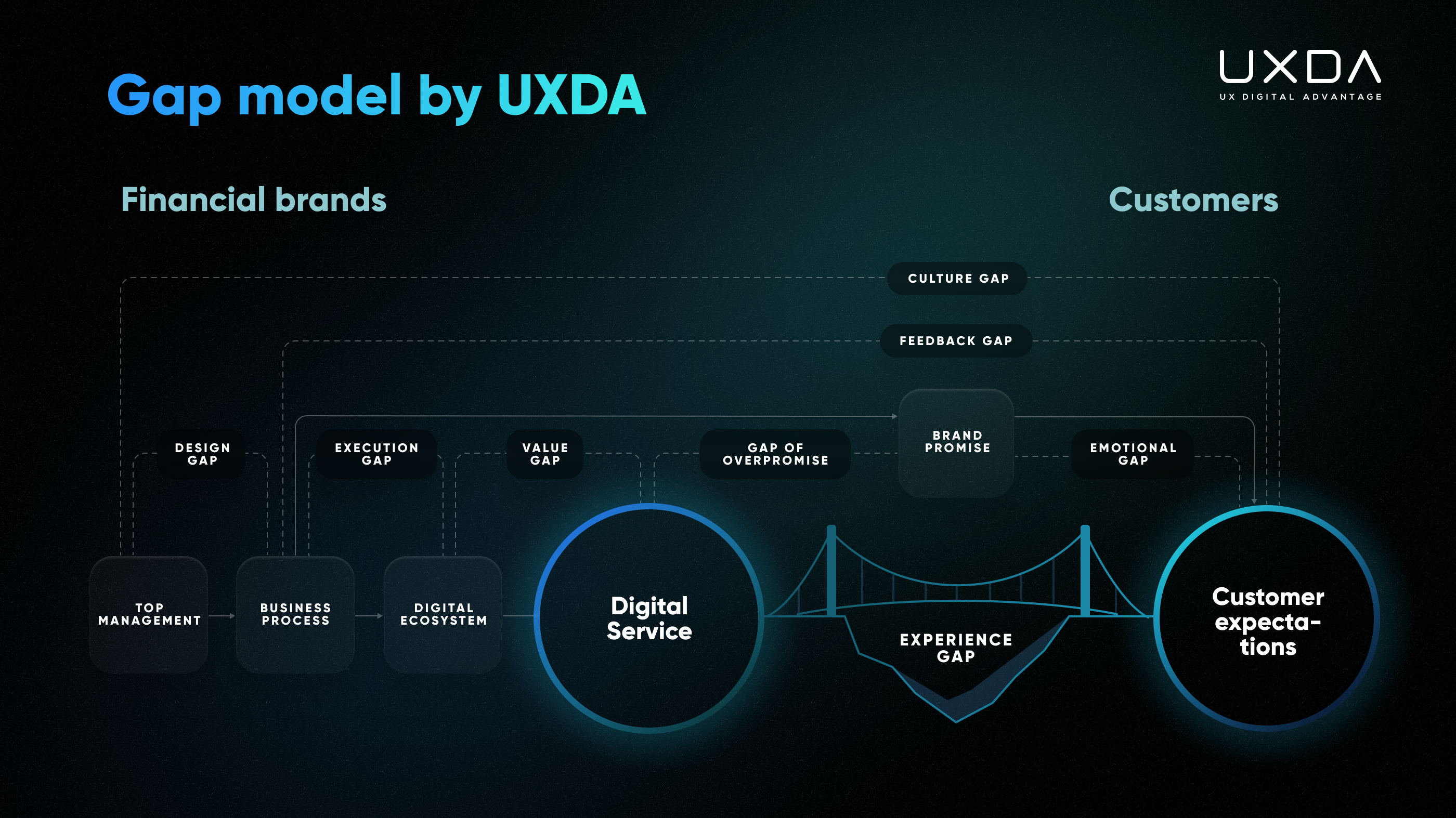
The Experience Gap model by UXDA
FIs that aim to succeed know how to detect and overcome the experience gap by not only fulfilling but exceeding customer expectations.
Following are the blind spots in one or several of the seven experience gap levels in the financial organization and ways that successful financial brands spot and fix them:
The Culture Gap
The lack of customer centricity in a company’s culture prevents employees from bringing service closer to customer expectations. The transformation begins with top management adopting a customer-centered experience culture and spreading this influence throughout the values of the company.
The Feedback Gap
This gap results from a lack of data about customer expectations and their experience OR collecting data but not acting upon it to solve user problems. The first step to bridging this gap is to do a deep dive into the most common complaints shared on social media and customer support calls. If a company is open to hearing critiques, it can use this data to bridge the gap and improve agility.
The Design Gap
This results from poor design execution. If user-centered product design is not a priority, decisions and efforts to create the final product and service are low quality and inefficient. A Design Pyramid framework bridges the execution gap by determining the five levels at which design integration will significantly increase a company’s efficiency: the process, the team, the actions, the results, and the value.
The Execution Gap
This is formed from incompetent design and poor methodology. Financial UX design methodology provides a step-by-step system for designing digital financial products that bridge the design gap and improve customer satisfaction.
The Value Gap
This gap is formed when the design ecosystem does not comply with user expectations. Creation of true value and customer benefit can be implemented through the 5 levels of the value pyramid: functionality, usability, aesthetics, status, and mission.
Gap of Overpromise
This is defined as promising something that the product cannot provide, leading to higher disappointment in user expectations. Digital-age customers demand transparency, care, honesty and open communication. We must make promises that can be fulfilled and even exceeded.
Emotional Gap
If brand communication is purely informational and focused on functional features, an emotional connection with users cannot be formed. Empathy toward customers is critical. Building an emotional connection between the brand and its customers will ensure long-term loyalty and demand. This connection is built through all of the aforementioned stages: a customer-centered mindset; making improvements based on feedback; using the right tools and methodology to create product design and the ecosystem; creating true value and benefit; and being honest and over-delivering on promises.
Each customer unconsciously evaluates the service they receive according to their expectations. The emotions caused by the quality of banking customer experience form the reputation of the financial brand. Digital channels have become the main marketing and PR of the brand. A negative experience with a mobile application can sabotage all brand promotion efforts. That's why it's so important to bridge these seven experience gaps that might arise when creating digital products.
4. Enriching the Customer Experience in Finance With an Emotional Connection
In the post-pandemic world, when any service or product will be available online or ordered remotely, great usability in itself won't be enough to succeed. This is when bridging the aforementioned emotional gap becomes critical. The ability to form an emotional connection with the customers is one of the key factors to ensure a financial brand's success.
Currently, 94% of Americans say that empathy from brands is more important than ever, according to the study “The Empathy Imperative: Consumer Perceptions On Brand Empathy Through a Pandemic.”
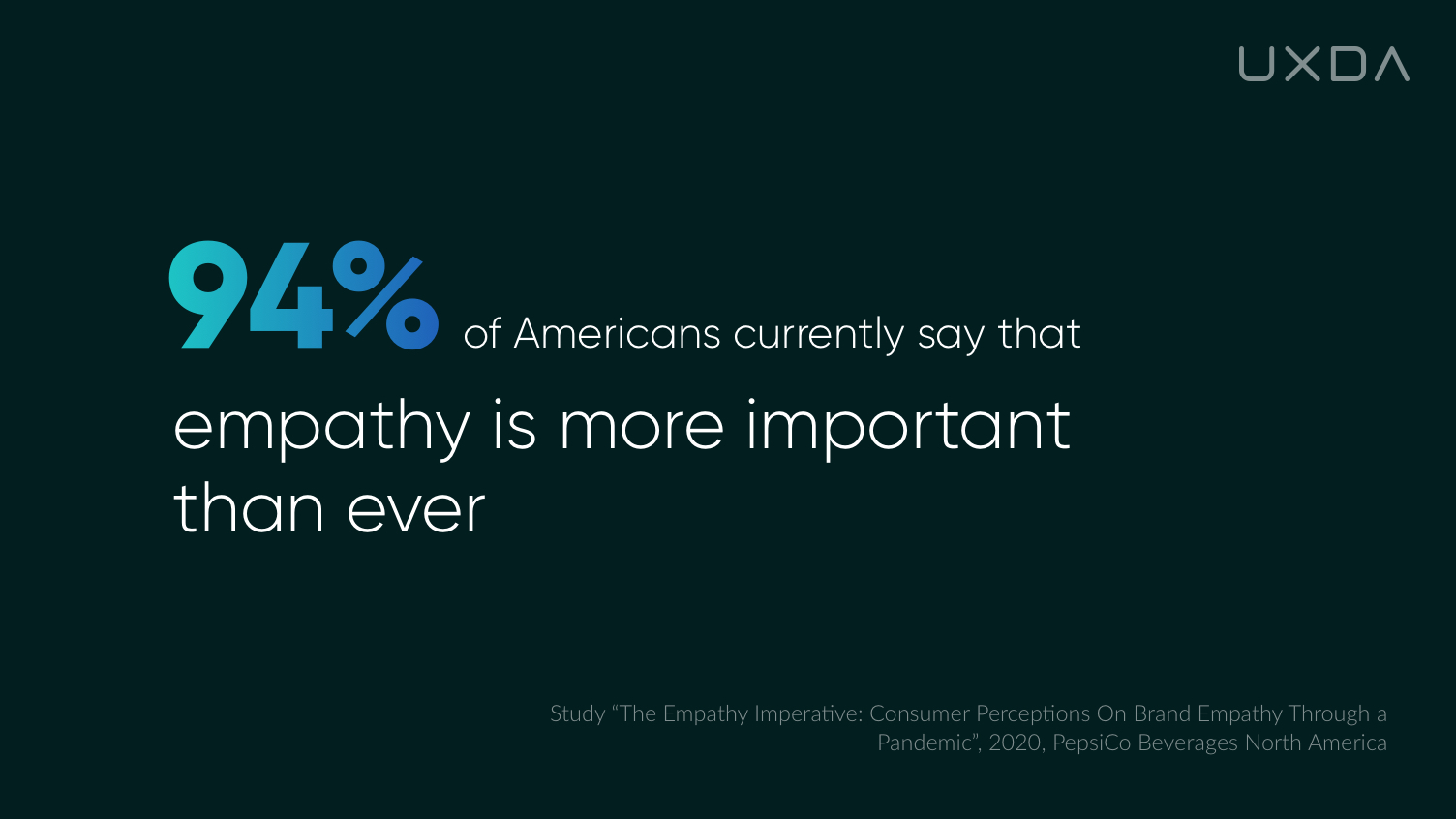
Moreover, consumers who have an emotional connection with a brand have a 306% higher lifetime value, stay with the brand for an average of 5.1 years vs. 3.4 years and will recommend brands at a much higher rate (71% vs. 45%), according to Motista.
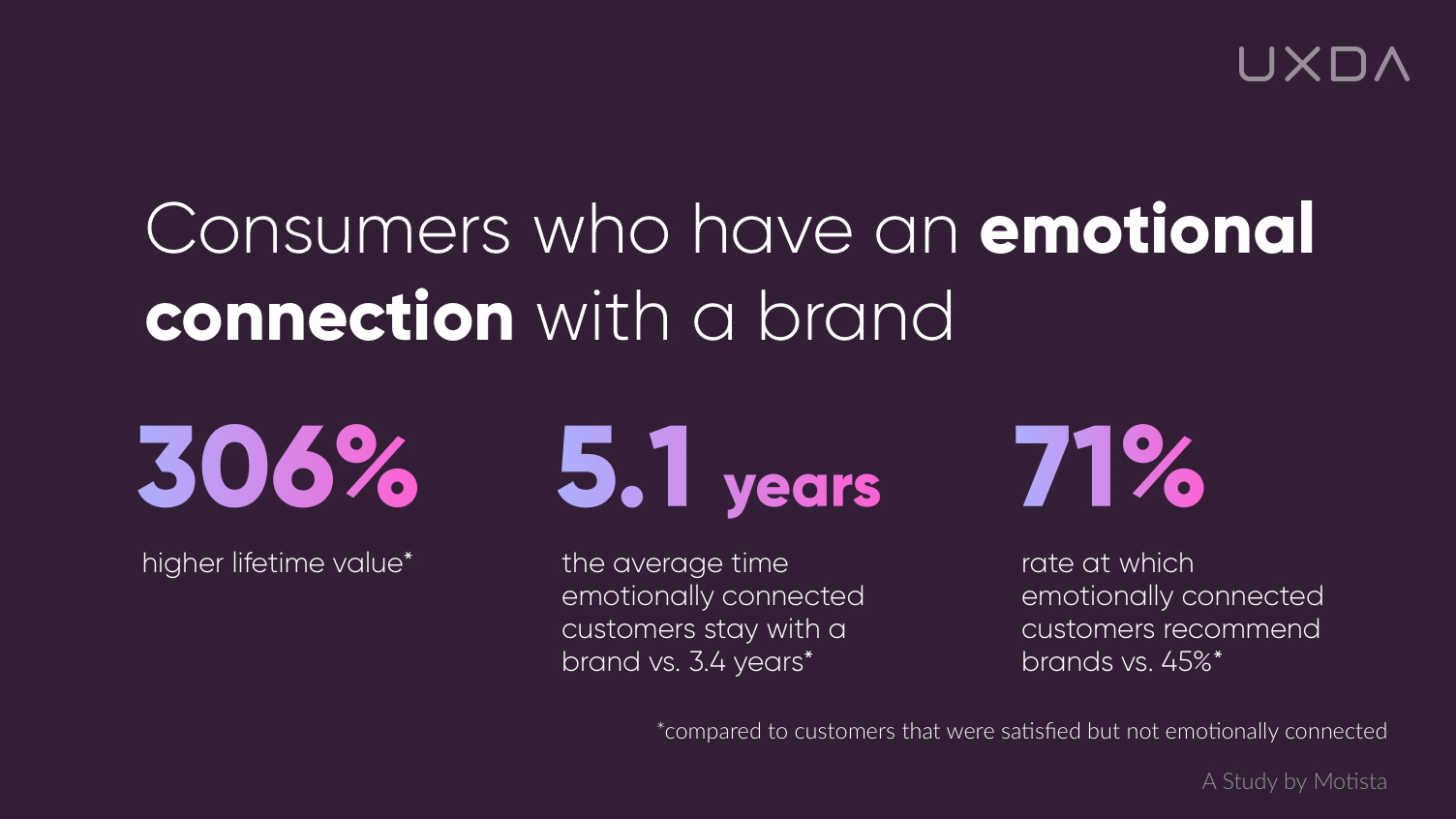
It often seems that the banking industry is afraid of emotions as if they would somehow reduce their notability. In fact, it's actually the opposite. Emotions are the language that resonates with people and makes them feel heard, understood and cared about.
That's why for FIs to succeed it's important not only to think about interface usability and digital innovations but also about the integration of personalized, positive experiences that form an emotional connection.
When customers compare their digital experiences, there's often quite a large gap between the usability and experience of social media platforms like Facebook and Instagram and their banking app. As 73% of customers say that an extraordinary experience with one company raises expectations of other companies, digital financial services might often cause disappointment. That's because customers are accustomed to the Big Tech products that are often smooth and enjoyable, and this forms their unconscious expectations.
To keep up with the experiences delivered by the Big Tech, finance companies should find out what users love about their products and think about how to integrate that to create a more emotionally engaging experience.
It's also often useful to honestly ask: does your brand experience convey that it puts the customers first, cares about them, provides needed solutions and wants to help in any way possible?
When the answer to this question will be a confident “yes” from the viewpoint of the customers, there will be no obstacles toward becoming a beloved financial brand.
It's important to remember that financial products are used by living people, not robots, so it's essential that the solutions evoke positive emotions in order to create an emotional bond.
5. Setting up Experience-Driven KPIs
As the digital paradigm is shifting more and more toward customer-centricity, it's crucial to re-think not only the company's inner culture and business approach but also the way its performance is being measured.
For decades, the key performance indicators (KPIs) have been the level of sales, conversion and the number of leads and prospects. But to become a successful financial brand in the new era, the main focus switches toward:
- user feedback;
- the number of actual users who recommend the product to friends;
- the number and reasons for complaints about the service;
- the number of positive and negative comments about the company on social media platforms.
To evaluate the impact of the user-centered actions that the company takes, there must be certain performance indicators in place that help to focus the team efforts in the right direction.
Many FIs are not even aware of the huge resources they already have without hiring a single UX expert. For example, there's a possibility of conducting user research on the performance of the mobile app, already defining what needs to be improved simply by using Google. This doesn't compare to thorough user research conducted by a financial UX architect, but it can definitely provide instant insights that would allow immediate improvement of the digital banking CX.
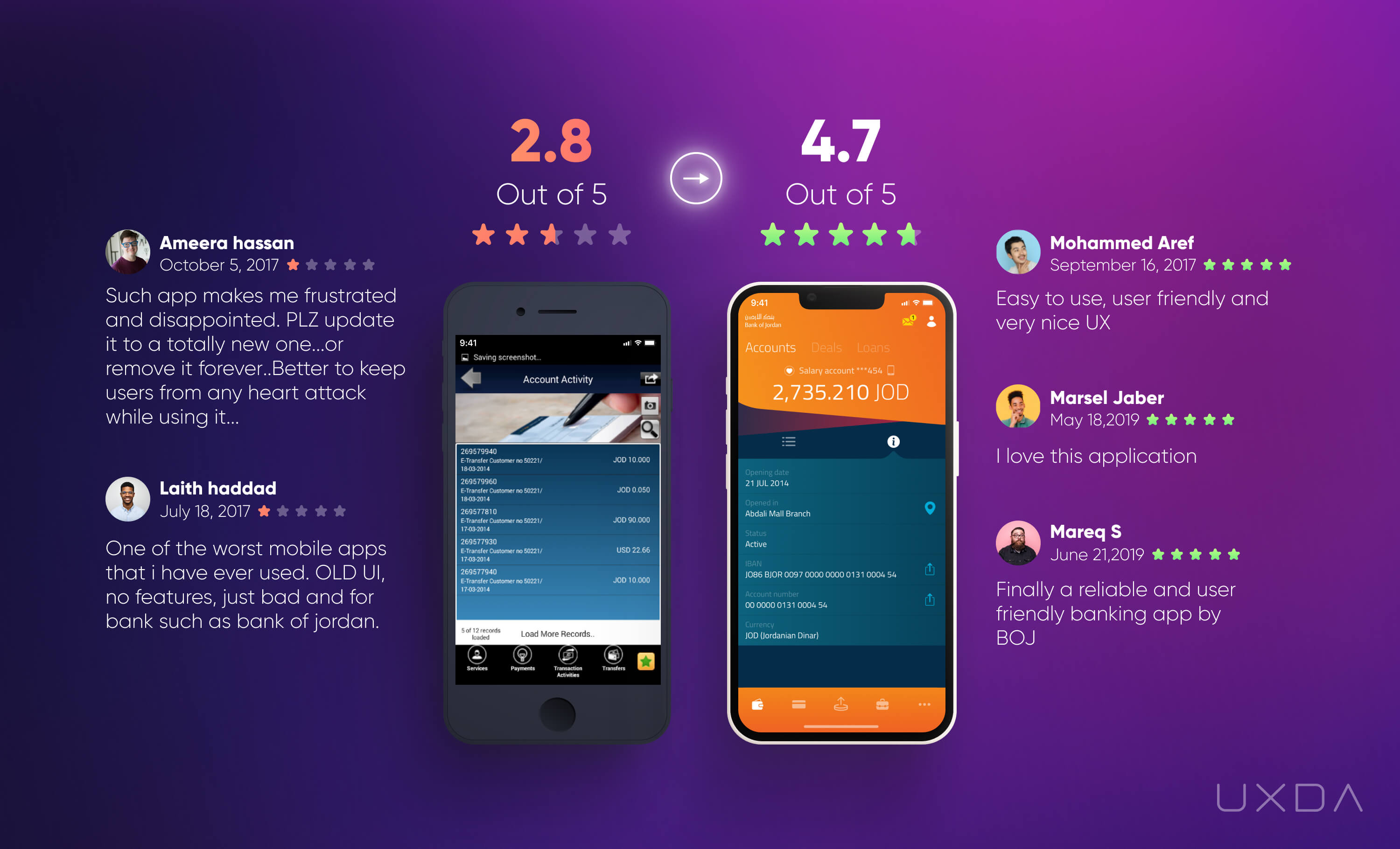
App reviews before and after the UX transformation of Bank of Jordan mobile banking app done by UXDA
Following are KPIs that FIs can focus on to measure the satisfaction of their customers and seek ways to improve it:
- app ratings on Google Play and the App Store;
- reviews and feedback on social media platforms, forums and other sites;
- NPS (net promoter score) - how likely customers are to recommend this banking product;
- customer lifetime value (CLV) - helps to understand the value of investing in long-term relationships with the customers;
- reasons why most users contact the support center;
- retention and switch rates;
- active customer volume;
- customer satisfaction rate;
- customer loyalty index.
6. Switching From IQ to EQ
The emergence of new technologies is rapidly increasing. As its essence is to ease our lives, it's very important that the innovations are easy to understand and use. To ensure that, it's not enough to have brilliant engineers with a highly developed IQ. There is a need for highly emotionally intelligent people who serve as translators between customers and the complexity of the opportunities uncovered by new technologies.
This explains why the demand for digital banking CX / UX experts is rapidly increasing. They are the "user advocates" that ensure a user-centered approach in digital product development.
In the digital age, the business focus is rapidly shifting from IQ to EQ─from intellect to emotion. The thinking of the brands is shifting from rational aspects like different performance metrics to emotional aspects like the satisfaction of the customers and employees, as well as building long-term relationships. EQ is all about the emotional impact the product or service of the brand has on people's lives.
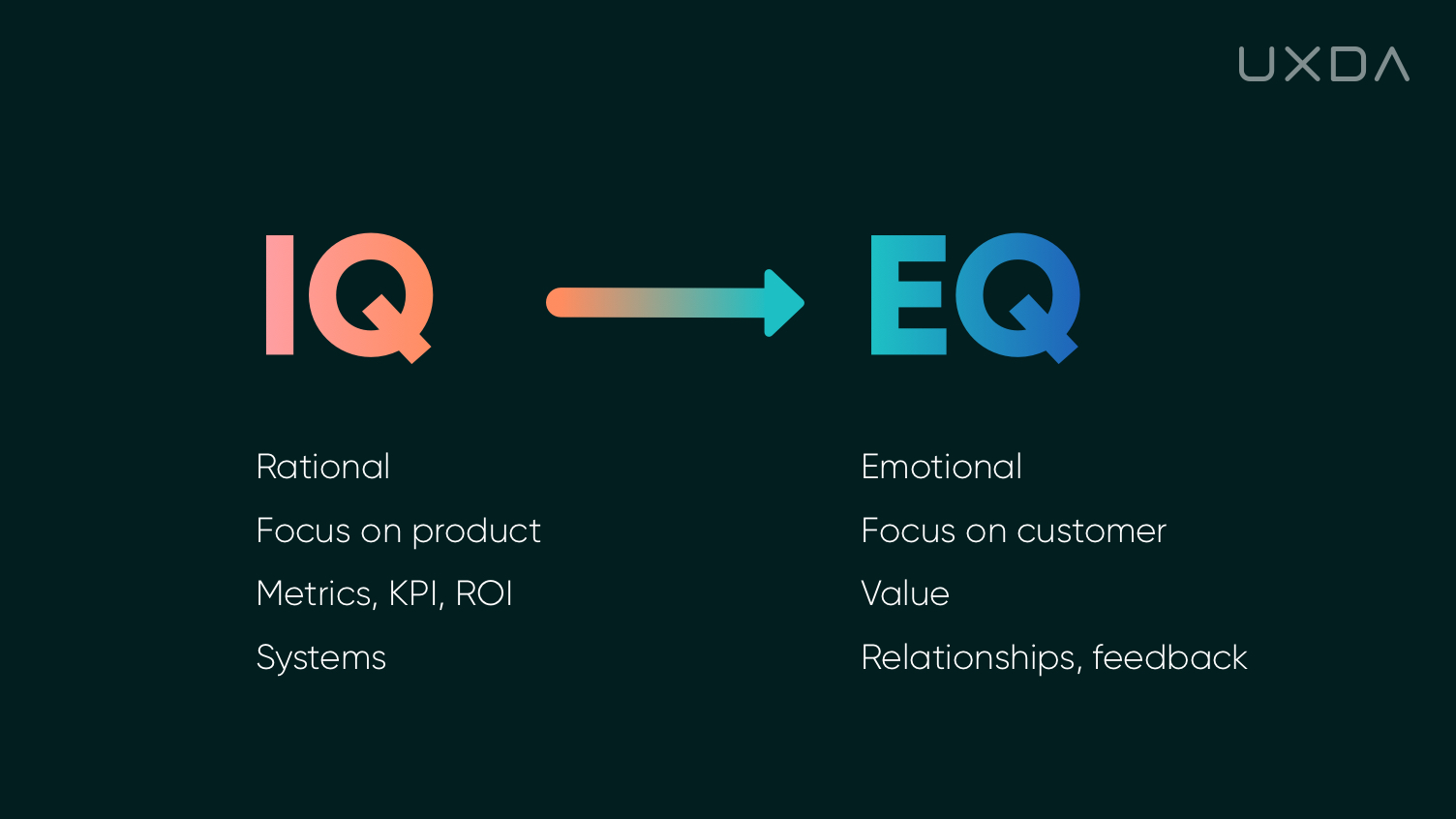
Currently, during the pandemic, emotional intelligence and empathy are more important than ever. Eighty-six percent of Americans have stated that, if brands want to create greater loyalty, it’s critical they show more empathy, according to the study “The Empathy Imperative: Consumer Perceptions On Brand Empathy Through a Pandemic.”
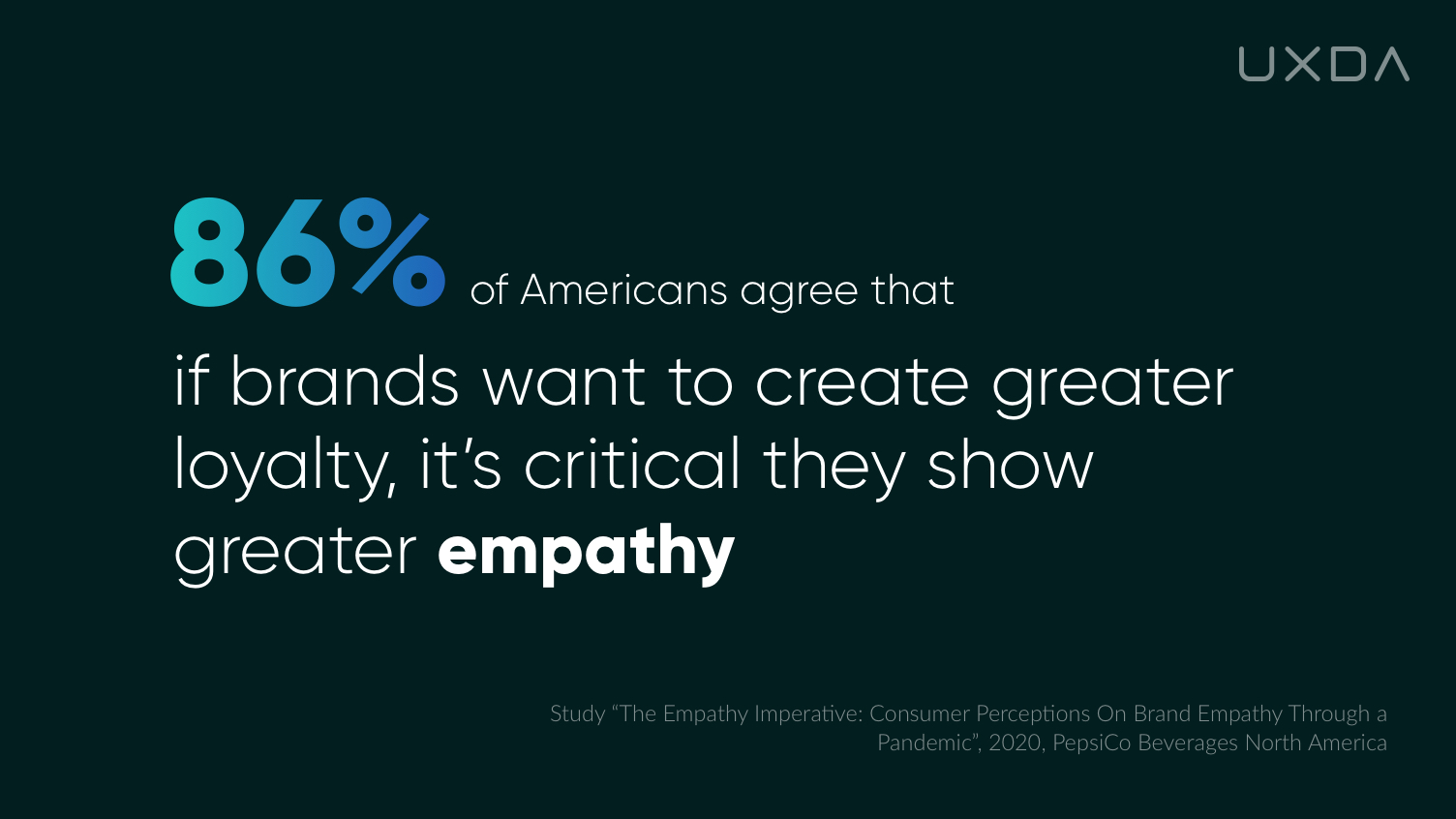
In the near future, empathy will be even more important than it is now. The fight for brand loyalty will just get harder, and customer expectations and demands for a more personalized experience will keep on rapidly increasing, as will the technological chances of satisfying them.
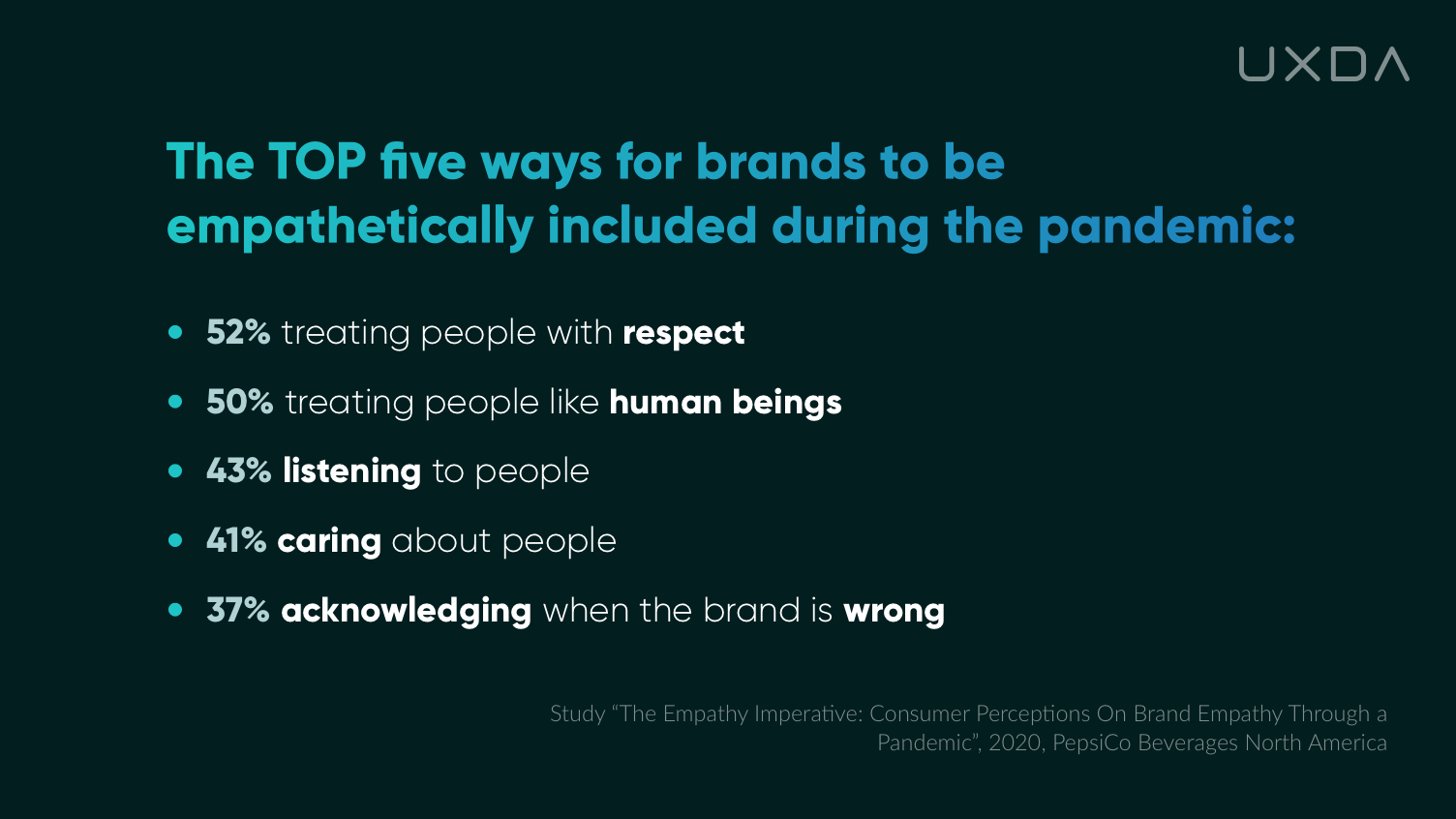
Future technologies, like artificial intelligence, big data, Machine Learning and automatization, have the ability to take customer experience to a brand new level. There is only one BUT─84% of customers state that one of the preconditions for them to stick with a brand is to feel that they are treated like a person, not a number, according to Salesforce.
What differentiates robots from people is the ability to feel emotions and empathy toward one another. This means that, while future technology might uncover superpowers for mankind, it's up to the actual people behind the machines that will determine the success of the outcome.
The success potential of modern technology will be either expanded or limited depending on the priorities of the people behind the robots.
What I mean by that is, even the most expensive, futuristic innovation can become useless or even dangerous for the financial brand success in a long-term if it's operated by people who lack empathy and are more focused on profit than on customer-centricity.
Successful financial brands in post-pandemic and beyond will be ones that unite the power of technological capabilities with the power of genuine empathy and emotional connection only humans can create.
7. Establishing Consistency Through Product Ecosystem
Often, many incumbents digitize their products separately. This causes high fragmentation within the financial customer experience as the usability, information architecture and the interface itself differ. Also, having different departments each working on their own product creates fragmentation.
This leads to a broken banking CX, because the users expect their banking services to be a connected, holistic flow and not separate fragments. Annoyed by this frustration and digital friction, customers might decide to switch to another financial company that offers consistency and smooth flow across all of their digital products.
Fragmentation breaks the financial customer experience by causing a lot of struggle and confusion. The main problem is caused by the lack of a united vision that would include all of the products and services provided by the financial institution. This is often due to the fact that digital channels are considered an alternative or additional form of service delivery.
Seventy-six percent of customers expect consistent interactions across departments. However, 54% say it generally feels like sales, service and marketing don’t share information, according to Salesforce.
Customers expect all of the channels to be equally well designed, communicating the same visual brand language and usability patterns. It shouldn't matter which of the platforms customers use; they all need to be holistically united to ensure consistency across all channels.
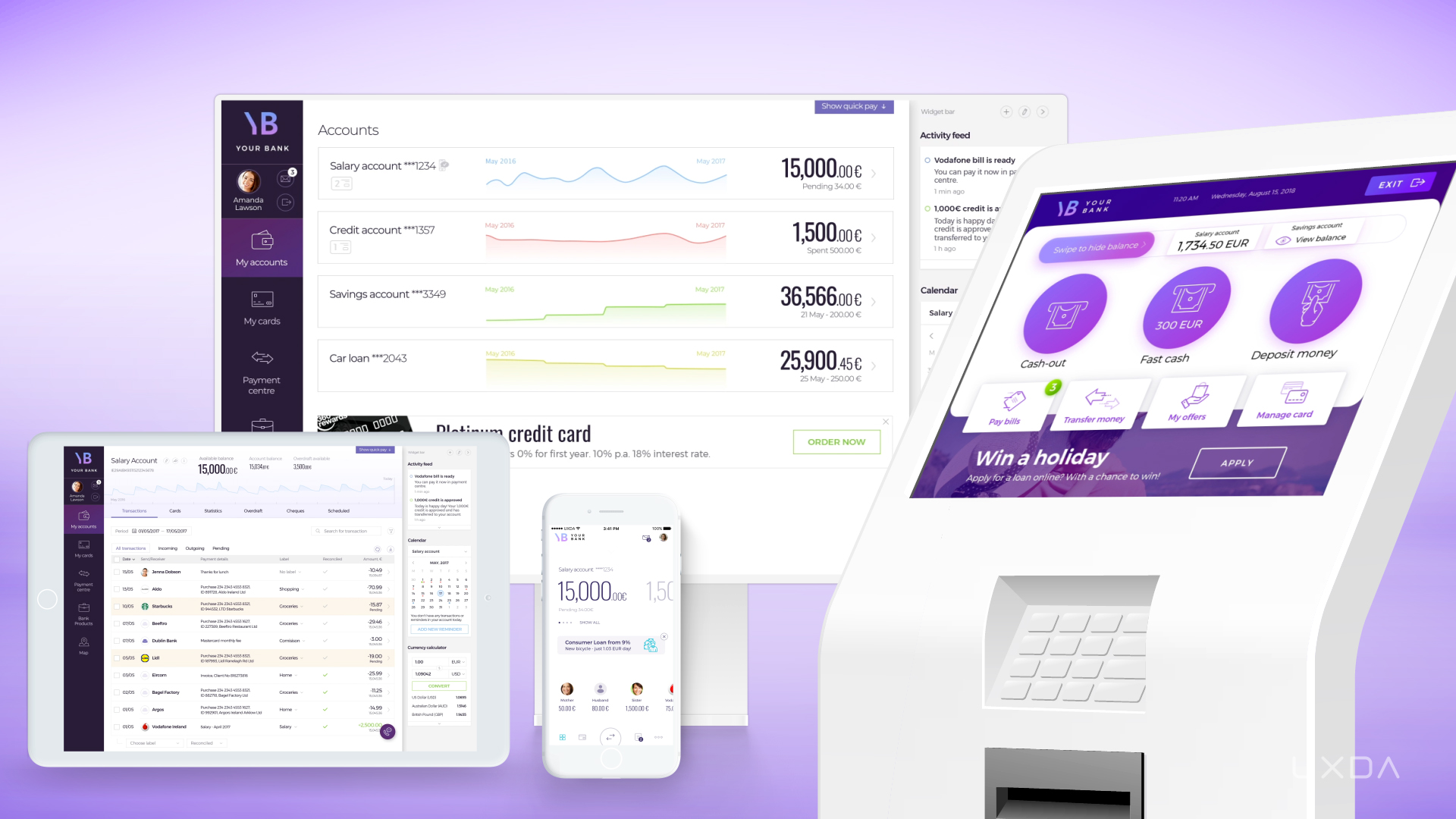
To avoid fragmentation, the departments of successful financial brands work together, constantly seeking ways to improve the customer experience across all channels. Another practical way to make this happen is to create a proper UX/UI design system and digital strategy. It ensures that everyone working on the ecosystem products are on the same page and can easily develop consistent digital solutions in their specific field of responsibility.
Successful financial brands earn the trust of their customers by overcoming organizational silos to create and develop a united, user-friendly ecosystem that ensures a smooth, connected flow of a delightful experience.
8. Providing a Contextual Financial Experience
Future will change the way powerful financial brands are built. The key to becoming a successful financial company post-COVID is having 100% focus on solving the customers’ problems in the most effective way possible, instead of following a standardized scenario. It requires having true empathy toward the customers─getting to know them, feeling their pain like your own and delivering a solution that will make their lives better and easier.
From a practical perspective, this calls for personalized, contextual banking experiences. As the number of advanced technological solutions of data processing and personalization through AI are becoming more and more accessible, it is broadening the opportunities FIs can offer their customers.
While 66% of customers expect companies to understand their personal needs and expectations, only 34% say they usually do so. Moreover, 52% of customers always expect offers to be personalized, according to Salesforce.
Personalized, contextual financial products powered by technology should:
- inform the users about any situation that requires their attention, even when they have thought of it themselves;
- help to improve users’ financial health by monitoring it and providing recommendations;
- make financial forecasts and offer uniquely crafted possibilities according to the user's specific needs and goals, in a specific context;
- in the near future, it should also enable the users to conduct financial operations using voice processing, gestures, neuralink, VR and AR.
An app that provides a contextualized experience should be able to predict the exact moment when a user needs a specific product, and provide it by combining big data with behavior-based predictive analytics. The data already available to the incumbents could be used to provide personalized offers based on the user’s purchasing and financial behavior.
While the kind of technology needed for this full range of contextualized experience might still not be fully developed, there are other options for starting to move in this direction. ChatGPT alike Generative AI can provide a conversational interface, and it aims to take personalization to a brand new level by using concierge services.
It's clear that the successful financial brands of the future will be the ones to utilize these technological advancements to the fullest, creating products that become the champions in personalization.
9. Teaming up With Fintech and Technology Companies
Actively introduced open banking initiatives have led to the emergence of multiple collaborations among banks and Fintech companies. The most advanced banks are actively investing in Fintech companies and integrating their technologies into their services.
It is already obvious to many that future success in the digital world depends on the willingness to collaborate. The readiness to integrate third-party solutions allows incumbents to improve the service package for users and deliver additional value. This opens up new possibilities.
But, new development opportunities are associated not only with Fintech but also with Big Tech. Banks that are transforming into digital companies are actively using Big Tech platforms and services to improve digital banking customer experience, optimize work processes and promote their services.
Technologies implemented by Big Tech companies set the vectors for the future development of the digital world. Some will ignore them and get disrupted soon, while others will collaborate and actively integrate to gain a competitive advantage.
The digital strategy of successful financial institutions must include guidelines for tracking, using and collaborating with Fintech and Big Tech companies. FI’s future digital potential depends on how quickly it’s able to utilize technologies introduced by Big Tech and adopt them. For example, banks that were late in connecting their cards to Google Pay and Apple Pay caused a lot of anger and frustration among customers who wanted to pay by smartphone.
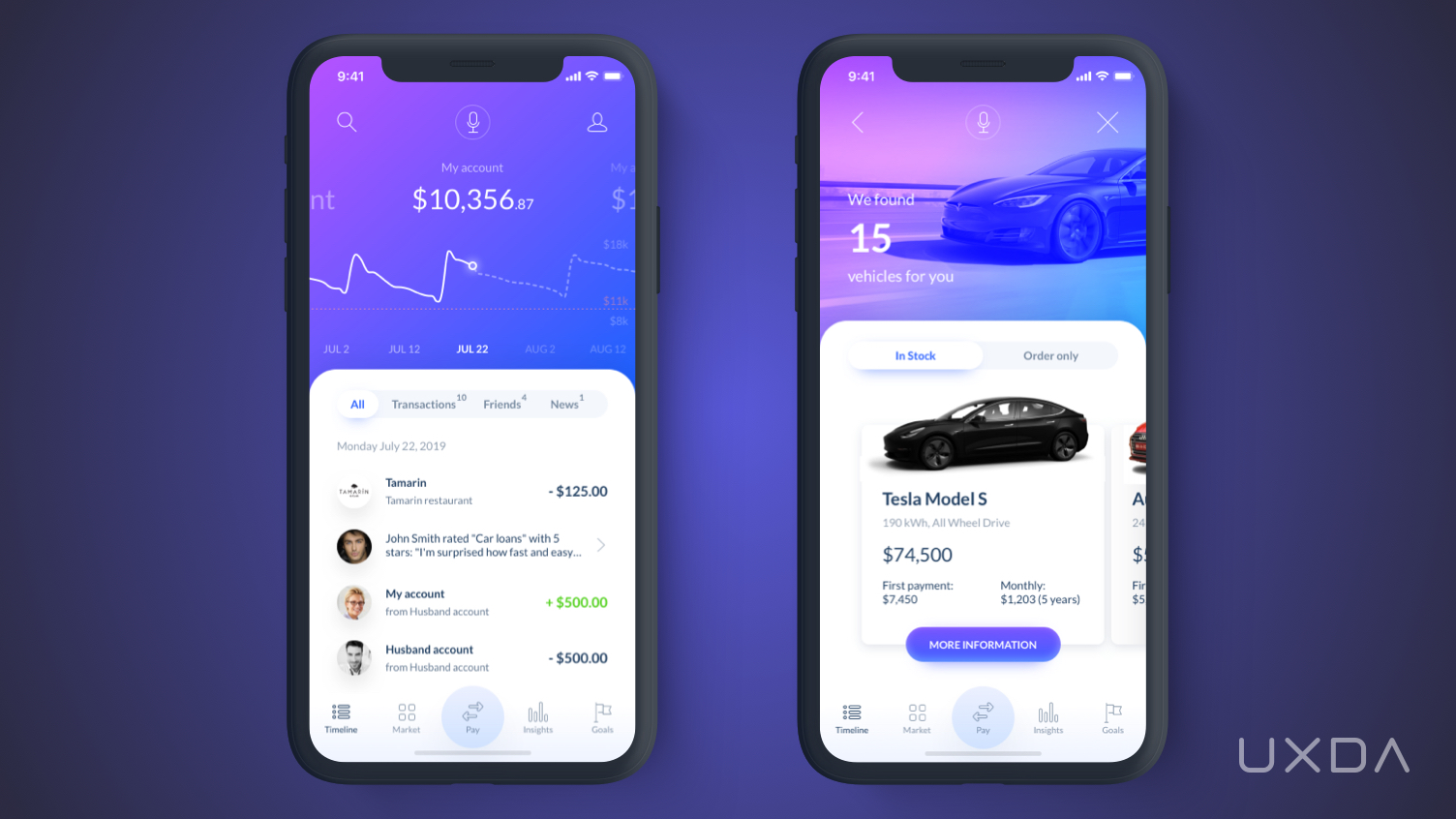
Banking Super App UX Design concept by UXDA that uses social-media like interactions
To meet customers’ expectations, advanced banks are already looking outside of the traditional financial industry. They bring digital experts to the table by collaborating with Fintech startups, UX architects, interface design professionals and user researchers who have an understanding of digital customers’ needs and behavior to create delightful financial products.
10. Taking the Value of Financial Customer Experience to a New Level
During the pandemic, the demand for digital services has skyrocketed. It was clear that going digital is a must to survive and strive in the foreseeable future. Also, different regulators and government agencies have been forced to respond to this global challenge by making the financial industry more open for newcomers, such as Fintechs. This has increased the demand for digital financial products and reduced market entry barriers.
As a result, in the post-pandemic era, we will witness the emergence of even more aspiring digital financial products. To survive and succeed in such circumstances, plain functionality or even acceptable usability are not enough.
Fifty-six percent of U.S. consumers switched brands during the pandemic due to the value provided. In fact, care, convenience, quality and value are the key aspects that leave a positive impression on the customer, according to McKinsey & Company COVID-19 US Consumer Pulse Survey.
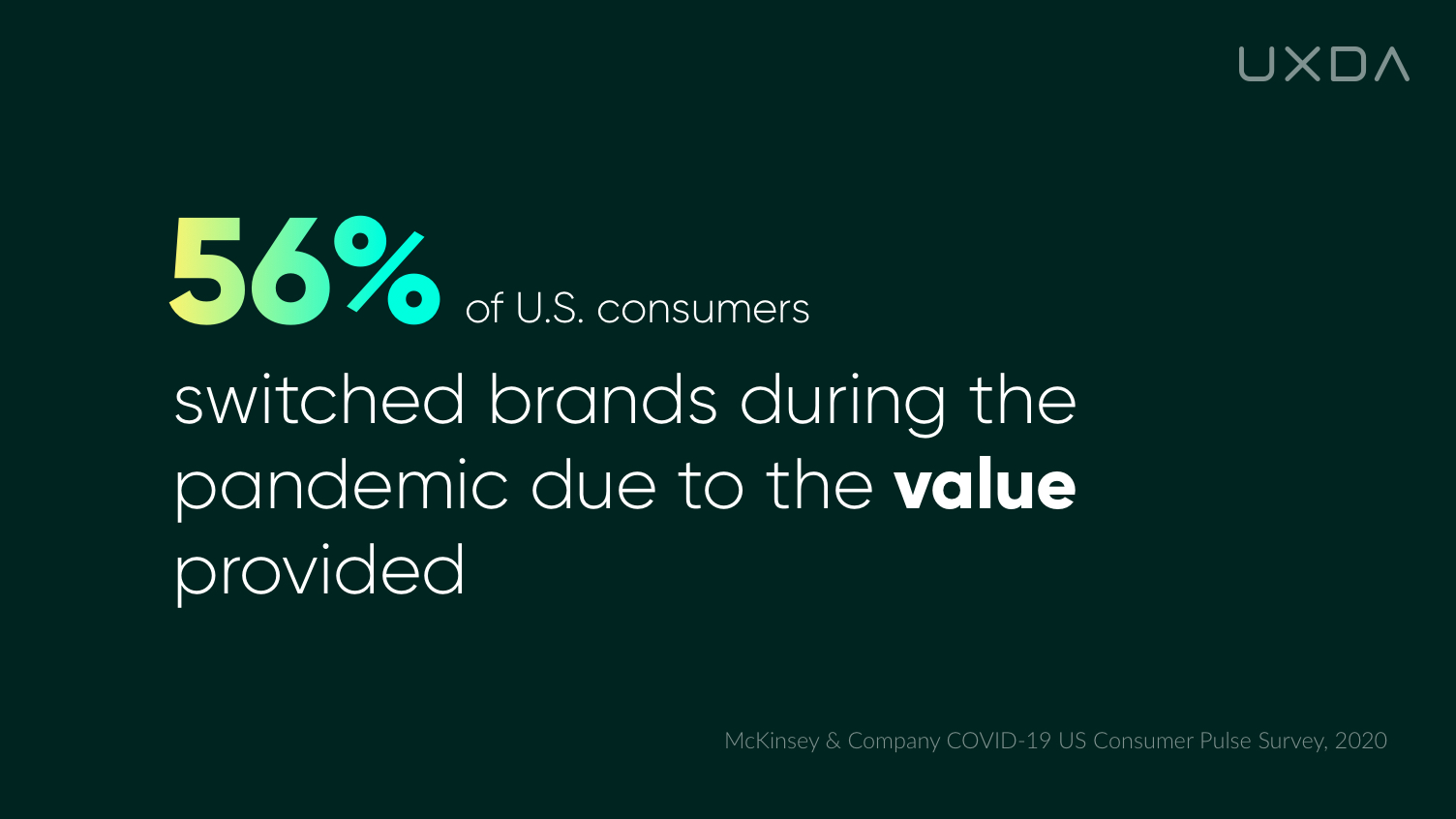
The new generation of post-COVID customers expects much more. To ensure a market advantage, financial products must provide an exceptional customer experience, look aesthetically pleasing, fit the specific requirements of the customer’s status and even present a socially significant mission that would create a community around it.
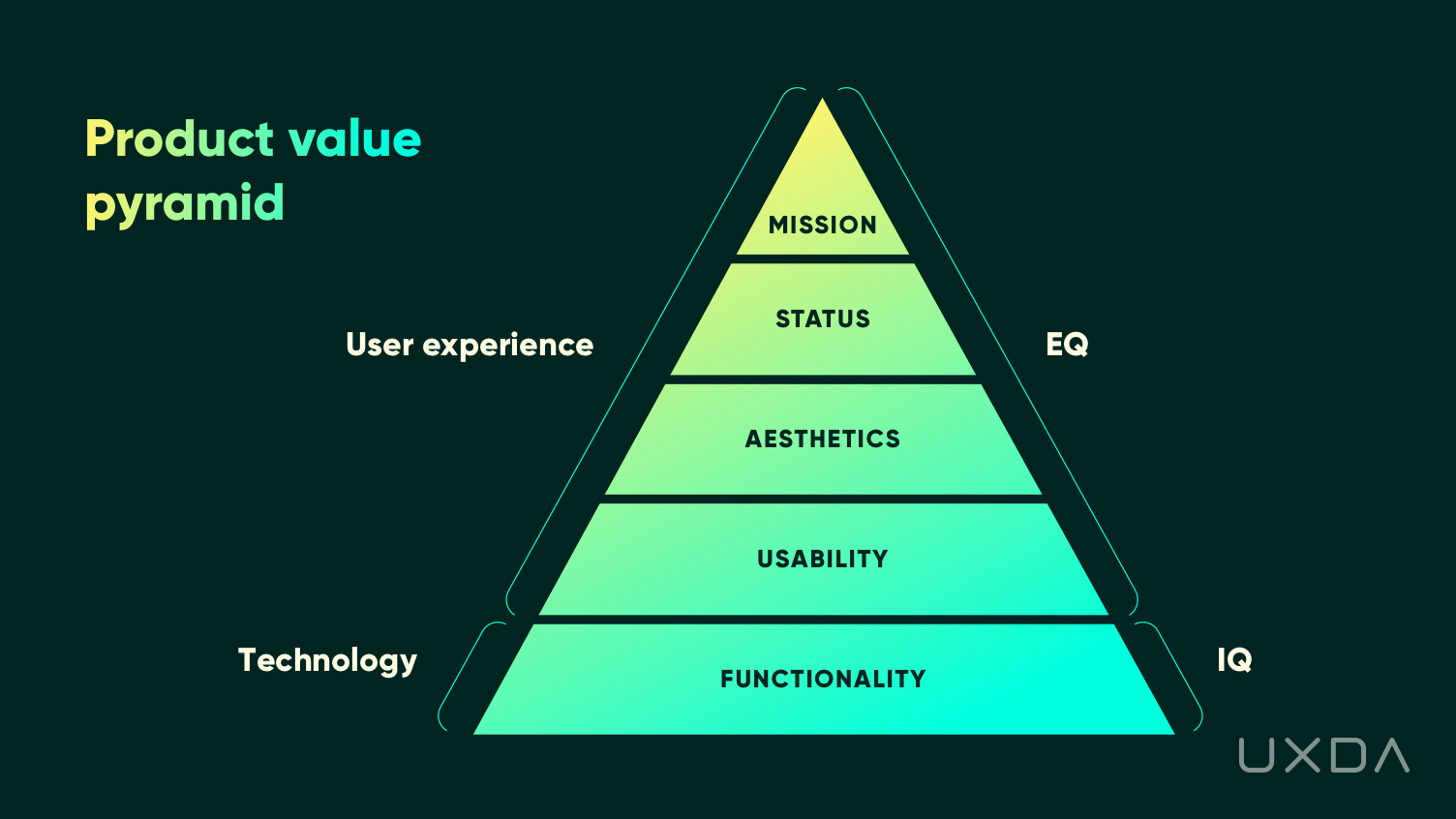
Shaping the product value through the 5 levels of the Value pyramid framework by UXDA
Most of the traditional incumbents are still offering basic functionality and working on improving usability. Customers are able to perform their basic daily scenarios, but it often causes struggle. The level of user experience is quite low, not to mention the positive emotions the service would cause through enjoyable design, gamification elements or animated interactions.
Meanwhile, new Fintechs keep overflowing the market with digital solutions that build upon the basic functionality by offering an amazing customer experience, in a modern eye-catching design and gathering thousands of fans around a brave mission statement.
For example, the Ant Forest program that was enabled in the Alipay app encouraged users to collect energy points to plant trees. Half a billion users took part in the Ant Forest, resulting in 100 million trees being planted, with a total area of almost a thousand square kilometres!
This is the time for incumbents to step up their game and provide the wide range of possibilities they have by upgrading their digital ecosystems of financial products. FIs can build up a great digital banking CX, work on a modern interface and connect to the specific characteristics of the customers by addressing the specific needs of their audiences, whether it be families, teens, seniors or VIPs.
Incumbents have such a deep loyalty and trust from their customers, formed throughout the years, that this is a huge advantage over the newcomers. When it comes to money, trust is everything. Eighty-two percent of customers agree that a company’s trustworthiness after the pandemic matters more than it did a year ago, according to Salesforce. Using it as a foundation, incumbents can build upon that by developing their products so that they would be not only functional but also very easy to use, to look at and recommend.
New World - New Possibilities
The lockdowns caused rapid changes that no one could predict, bringing with it great responsibility toward the customers. The pandemic has been a hard hit for the whole world. Nobody expected it, but it happened with all the resulting damage and consequences. The world will never be the same.

This is the time when every business is reminded of why it exists and what it has to offer to its clients. In such circumstances, it's all about finding the best ways to serve the customers and ease their daily struggles. If the customers see that the financial brand has their back, cares about them and is actively looking for more and more ways to help, the company will receive trust, loyalty and respect in such scope and intensity that would be impossible outside of the context of the crisis. So, I encourage you to view it as an opportunity to take the business to a brand new level by forming long-lasting emotional connections with the customers in the post-pandemic world.
Explore 10 Digital Banking Design Trends
Get UXDA Research-Based White Paper "How to Win the Hearts of Digital Customers":
 If you want to create next-gen financial products to receive an exceptional competitive advantage in the digital age, contact us! With the power of financial UX design, we can help you turn your business into a beloved financial brand with a strong emotional connection with your clients, resulting in success, demand, and long-term customer loyalty.
If you want to create next-gen financial products to receive an exceptional competitive advantage in the digital age, contact us! With the power of financial UX design, we can help you turn your business into a beloved financial brand with a strong emotional connection with your clients, resulting in success, demand, and long-term customer loyalty.
- E-mail us at info@theuxda.com
- Chat with us in Whatsapp
- Send a direct message to UXDA's CEO Alex Kreger on Linkedin


